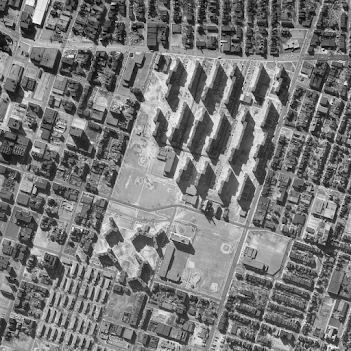Pruitt Igoe
The infamous Pruitt Igoe housing complex has an established negative connotation due to its rise and detrimental fall in St. Louis, Missouri. The architect, Minoru Yamasaki designed the housing complex to aid with public housing needs in the area while aesthetically appealing to the Modernist Movement that was prominent during this time. The project was massive and consisted of thirty three buildings that could house 12,000 people. This project was intended to solve the project of housing that allowed people who were typically only accepted into the slums, a nice place to live and call home.
Upon moving into Pruitt Igoe, many tenants remember feeling a warm sense of family and community. The complex enabled residents that were categorized as disadvantaged to have views of the city while having access to modern technology. Ideally Pruitt Igoe was supposed to be a “safe place” for residents. However, as the development was established for a long time a statement was made saying, “people who didn't live there thought it wasn't a good place to live.” This statement turned out to be a true statement as the development progressed.
Pruitt Igoe became a breathing ground for vandalism and isolation that many residents began to experience. Maintenance began to go down due to the housing authority not being able to afford the upkeep. Honestly, many affordable housing complexes have good intentions with aesthetically pleasing buildings but they never seem to factor in the maintenance of these projects. Another issue arose of the housing authority not allowing two parent households to move in unless for instance the father did not move in with them. I think the thought process to that happening was that a two parent household is not struggling enough to need affordable housing. However, many people apply for jobs but are discriminated against.
Overall, Pruitt Igoe had great intentions of solving the housing issue but I believe this project could have been more maintainable at a smaller scale.



Comments
Post a Comment